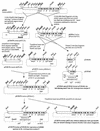Improved system for protein engineering of the hydroxylase component of soluble methane monooxygenase
- PMID: 12406713
- PMCID: PMC129910
- DOI: 10.1128/AEM.68.11.5265-5273.2002
Improved system for protein engineering of the hydroxylase component of soluble methane monooxygenase
Abstract
Soluble methane monooxygenase (sMMO) of Methylosinus trichosporium OB3b is a three-component oxygenase that catalyses the O(2)- and NAD(P)H-dependent oxygenation of methane and numerous other substrates. Despite substantial interest in the use of genetic techniques to study the mechanism of sMMO and manipulate its substrate specificity, directed mutagenesis of active-site residues was previously impossible because no suitable heterologous expression system had been found for expression in a highly active form of the hydroxylase component, which is an (alphabetagamma)(2) complex containing the binuclear iron active site. A homologous expression system that enabled the expression of recombinant wild-type sMMO in a derivative of M. trichosporium OB3b from which the chromosomal copy of the sMMO-encoding operon had been partially deleted was previously reported. Here we report substantial development of this method to produce a system for the facile construction and expression of mutants of the hydroxylase component of sMMO. This new system has been used to investigate the functions of Cys 151 and Thr 213 of the alpha subunit, which are the only nonligating protonated side chains in the hydrophobic active site. Both residues were found to be critical for the stability and/or activity of sMMO, but neither was essential for oxygenation reactions. The T213S mutant was purified to >98% homogeneity. It had the same iron content as the wild type and had 72% wild-type activity toward toluene but only 17% wild-type activity toward propene; thus, its substrate profile was significantly altered. With these results, we have demonstrated proof of the principle for protein engineering of this uniquely versatile enzyme.
Figures


References
-
- Brusseau, G. A., H.-C. Tsien, R. S. Hanson, and L. P. Wackett. 1990. Optimization of trichloroethylene oxidation by methanotrophs and the use of a colorimetric assay to detect soluble methane mono-oxygenase activity. Biodegradation 1:19-29. - PubMed
-
- Buzy, A., A. L. Millar, V. Legros, P. C. Wilkins, H. Dalton, and K. R. Jennings. 1998. The hydroxylase component of soluble methane monooxygenase from Methylococcus capsulatus (Bath) exists in several forms as shown by electrospray-ionisation mass spectrometry. Eur. J. Biochem. 254:206-209. - PubMed
Publication types
MeSH terms
Substances
LinkOut - more resources
Full Text Sources
Other Literature Sources

